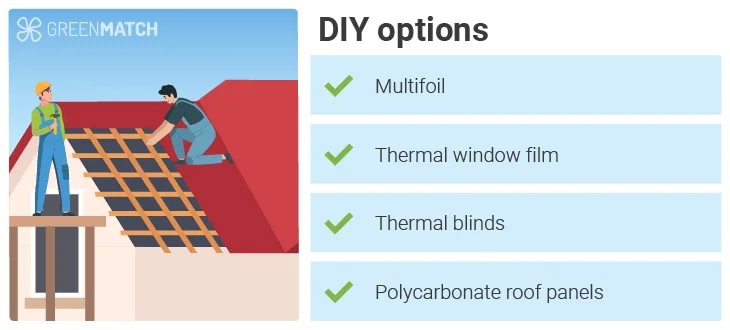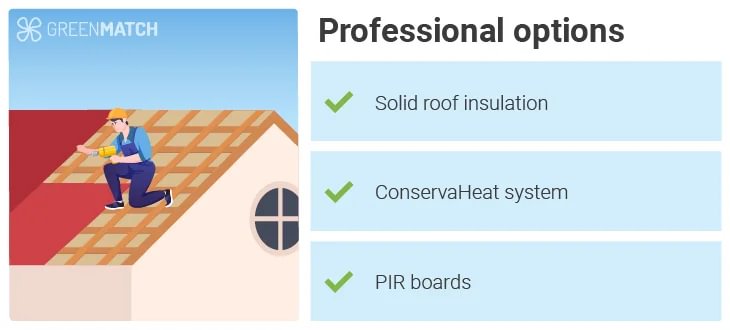Answer these simple questions and we will find you the BEST prices
Which type of solar quotes do you need?
It only takes 30 seconds
100% free with no obligation

Get Free quotes from insulation specialists near you

Save money by comparing quotes and choosing the most competitive offer

The service is 100% free and with no obligation
- GreenMatch
- Insulation
- Insulating Your House
- DIY Conservatory Roof Insulation
Your Guide to DIY Conservatory Roof Insulation


- Several DIY-friendly methods exist for insulating a conservatory roof, including multifoil insulation, thermal window film, thermal blinds or curtains, and polycarbonate roof panels.
- Effective DIY insulation typically requires specific material thicknesses to ensure good thermal performance, such as 25mm for multifoil insulation and 16mm for polycarbonate panels.
- While DIY insulation methods can save money and offer a sense of accomplishment, professional installation guarantees better insulation and a higher-quality finish.
Insulating a conservatory roof can be done through DIY methods like multifoil insulation, thermal window films, or thicker polycarbonate panels. These are affordable and accessible for most homeowners, though they may not match the insulation quality of professional installations and carry some risks if not done correctly.
Professional options, such as solid roof conversions or the ConservaHeat Multi-foil Insulation System, deliver superior results but require specialised expertise. Though more costly, professional installations ensure better insulation, adherence to safety standards, and long-term benefits like improved energy efficiency and home value.
If you want to insulate your conservatory, carefully consider the pros and cons of DIY versus professional insulation. In this guide, we will examine the above methods to help you make an informed decision.
Transform your conservatory into a comfortable, energy-efficient space today. Fill out our quick form to get free quotes from top local experts. Click the button to get started!
- Describe your needs
- Get free quotes
- Choose the best offer
It only takes 30 seconds



Can you insulate a conservatory roof yourself?
Yes, you can insulate a conservatory roof yourself, and several DIY-friendly methods exist. However, some methods are better left to professionals.
DIY methods

Several insulation methods are suitable for DIY if you're inclined to tackle the project yourself. These typically require basic tools and skills, making them accessible to many homeowners.
- Multifoil insulation: This involves attaching reflective foil insulation beneath the existing roof. It’s a relatively simple process that involves fitting timber battens, stapling the insulation, and finishing with plasterboard or uPVC cladding.
- Thermal window film: Ideal for glass conservatories, applying this film reduces glare and improves insulation. It’s straightforward and manageable for most DIY enthusiasts, though it offers less comprehensive insulation.
- Thermal blinds or curtains: Installing thermal blinds or curtains is an easy DIY option that helps retain heat in winter and cool the conservatory in summer.
- Polycarbonate roof panels: Replacing older panels with more thermally efficient ones can be a DIY project if you're comfortable with basic hand tools and working at height.
Professional methods

For more complex or permanent solutions, it's advisable to seek professional help from conservatory insulation specialists. These methods often require specific expertise or tools and can significantly impact the conservatory's structural integrity.
- Solid roof insulation: Converting your conservatory to a solid tiled or panel roof requires professional installation. This method offers the best insulation and necessitates structural adjustments that experts best handle.
- ConservaHeat Multi-foil Insulation System: This high-performance insulation system is designed for professional installation only. It involves advanced materials and techniques to maximise energy efficiency, making it unsuitable for DIY.
- PIR Boards (Polyisocyanurate): While effective, these rigid insulation boards require precise cutting and fitting, often making professional installation necessary to ensure a proper seal and adequate insulation.
Different DIY methods to insulate your conservatory roof
Insulating your conservatory roof can significantly improve energy efficiency, making the space more comfortable year-round. Fortunately, several DIY conservatory roof insulation methods are accessible for homeowners, requiring only basic tools and skills. Adding insulation can reduce heat loss during winter and minimise overheating in the summer.
This section will briefly explain different DIY internal conservatory roof insulation techniques.
DIY internal conservatory roof insulation
One effective DIY internal conservatory roof insulation method is using multifoil insulation. Attach timber battens to the underside of the conservatory roof to do this. Then, cut the multifoil insulation to size and staple it securely to the battens. For optimal performance, the multifoil should be around 25 mm thick. Finally, cover the insulation with plasterboard or uPVC cladding. This method helps reduce heat loss and improve comfort throughout the year.
Stick-on conservatory roof insulation
Another simple method is applying stick-on conservatory roof insulation. This involves using thermal window film, which is easy to apply directly to the glass panels. Clean the glass thoroughly before applying the film, ensuring no bubbles or creases. The film should be around 0.1 to 0.2 mm thick for adequate insulation. While less robust than other methods, this option is quick and enhances energy efficiency.
Installing thermal blinds or curtains
Installing thermal blinds or curtains is a more straightforward DIY method for conservatory roof insulation. Choose blinds or curtains with a thermal lining, which helps regulate the temperature inside the conservatory. These blinds or curtains can be installed directly onto the roof windows. Although they provide moderate insulation, they are excellent at reducing heat gain during the summer and retaining warmth in winter.
Installing polycarbonate roof panels
Upgrading to thicker polycarbonate roof panels is another effective DIY conservatory roof insulation method. Replacing older panels with newer, more thermally efficient ones can reduce heat loss and improve insulation. Polycarbonate panels should be at least 16 mm thick for better thermal performance.
Using DIY insulation kits
For a more straightforward approach, consider using DIY insulation kits. These kits come with pre-cut materials like foam panels or reflective foil and detailed instructions, making them an excellent option for those seeking a guided process. Ensure the insulation material is around 25 mm thick for optimal results.
Applying insulating roof panels
Insulating roof panels can be a practical option. These panels are designed to be lightweight and easy to install under existing conservatory roofs. They typically come with a built-in reflective layer that helps reduce heat loss. Ensure the panels are at least 25 mm thick to achieve good thermal performance when installing. This method is prevalent in the UK due to its balance of insulation efficiency and ease of installation.
DIY conservatory roof insulation vs professional
Deciding between DIY conservatory roof insulation and hiring professionals is a significant choice that can impact your home's comfort, energy efficiency, and value. Both approaches have their merits and drawbacks.
Below, we delve into the pros and cons of DIY conservatory insulation and explore the advantages of opting for professional services.
Pros and cons of DIY insulation
Embarking on a conservatory roof insulation DIY project can be exciting and rewarding. It offers homeowners the opportunity to personalise their space and potentially save on costs. However, weighing the benefits of DIY insulation against the potential challenges is essential.
- Cost-effective: Undertaking DIY internal conservatory roof insulation can significantly reduce labour costs. Materials like stick-on conservatory roof insulation or thermal window films are inexpensive and readily available.
- Flexibility: DIY projects allow you to work independently, accommodating your schedule and preferences. You can choose materials, methods, and designs that align with your vision.
- Skill development: Engaging in a conservatory insulation DIY project enhances your DIY skills and provides a sense of accomplishment upon completion.
- Limited effectiveness: DIY methods might not match the insulation efficiency achieved by professional installations. Techniques like applying thermal window film or installing blinds may offer only marginal improvements in thermal performance.
- Risk of improper installation: Without professional expertise, there’s a higher chance of mistakes. Incorrect installation of materials can lead to issues like condensation, drafts, or even structural problems.
- Time-consuming: DIY projects can be time-intensive, especially for those unfamiliar with construction or insulation work. This might lead to prolonged exposure to unfavourable conditions in the conservatory.
- Safety concerns: Working at heights or handling certain insulation materials can pose safety risks. DIY projects can also be hazardous without proper equipment or knowledge.
Advantages of professional installation
Opting for professional insulation for conservatory roof DIY projects offers many benefits that often outweigh the initial conservatory roof insulation cost. Professionals offer expertise, quality assurance, and efficiency.
- Expertise and experience: Professionals possess in-depth knowledge of various insulation materials and methods. They can assess your conservatory's unique needs and recommend the most effective solutions.
- Quality assurance: Professional installations often come with warranties or guarantees, ensuring that the work meets industry standards and provides peace of mind.
- Advanced materials and techniques: Professionals can access high-quality materials and advanced installation techniques that may not be available to the average DIYer, resulting in superior insulation performance.
- Time efficiency: Experienced installers can complete the job more quickly and efficiently, minimising disruption to your daily life.
- Compliance with regulations: Professionals are well-versed in local building codes and regulations, ensuring that your conservatory meets all necessary standards.
- Enhanced aesthetics: A professionally insulated conservatory often boasts a higher-quality finish, enhancing your home's appearance and value.
While DIY conservatory roof insulation can save money and be satisfying, it might only sometimes provide the best thermal efficiency or appearance. Although more expensive upfront, professional installation ensures high-quality workmanship, adherence to safety standards, and long-term benefits. To maximise the comfort and value of your conservatory, consider reaching out to experts in the field.
Ready to transform your conservatory into a comfortable, energy-efficient space? Get multiple quotes from our network of trusted installers today and take the first step towards a better home environment. First, fill out our 30-second form and receive up to three free quotes. We’ll match you with the best local specialists. Click the button to get started!
- Describe your needs
- Get free quotes
- Choose the best offer
It only takes 30 seconds



FAQ
You can install a conservatory roof using DIY methods such as multifoil insulation, thermal window film, or thermal blinds. These methods are generally straightforward and cost-effective, but they may not provide the same level of insulation as professional installations.
The cheapest way to cover a conservatory roof is to apply thermal window film or install thermal blinds. These options are inexpensive, easy to install, and offer a basic level of insulation.
Insulating a conservatory roof can significantly improve thermal efficiency, reduce energy costs, and make the space more comfortable year-round.
For effective insulation, materials like multifoil should be around 25mm thick, while thermal window films are typically 0.1 to 0.2 mm thick. Polycarbonate roof panels should be at least 16mm thick for better insulation.

Nicole Bea Kerr is a content writer for Greenmatch, leveraging her experience in B2B journalism and editing. She is interested in bringing more awareness to sustainability through informative narratives.
We strive to connect our customers with the right product and supplier. Would you like to be part of GreenMatch?

